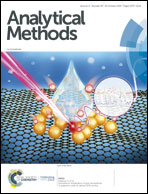Curcumin a colorimetric and fluorimetric cyanide probe in aqueous system and living cells
Abstract
Curcumin, 1,7-bis(4-hydroxy-3-methoxyphenyl)-1,6-hepta-diene-3,5-dione, is a natural product obtained from the rhizome of Curcuma longa. Curcumin has been demonstrated to be a strong antioxidant with anticancer properties and other diverse biological activities. In addition, curcumin and its derivatives have been applied in chemo sensing for the detection of cations, anions, molecular recognition and bio imaging. Herein, we have investigated the development and application of curcumin as a molecular probe for the detection of cyanide in aqueous medium. Cyanide causes a dramatic color change of the curcumin solution (acetonitrile : water 90 : 10) from bright yellow to dark orange. It causes dramatic spectral changes in the UV-vis spectrum of curcumin by the decrease in the absorption band intensity at 421 nm and a concomitant appearance of a strong band at 520 nm. A bathochromic shift of 99 nm is also observed. Other monovalent anions tested such as F−, Cl−, Br−, I−, AcO−, H2AsO4− and N3− caused no significant color or spectral changes. Hydroxide did show a similar change but gave a more intense color. The lower limit of detection was determined to be 2.3 × 10−6 M. The fluorescence emission of curcumin at 520 nm was quenched upon the addition of cyanide, while other anions tested caused no change. Curcumin was introduced into living cells and it was observed to have strong fluorescence. Upon the addition of cyanide, the fluorescence in the cells quenched slowly with time. We were able to use cyanide as a tool for the detection and quantification of curcumin in aqueous media using both UV-vis and fluorescence spectroscopy.



 Please wait while we load your content...
Please wait while we load your content...